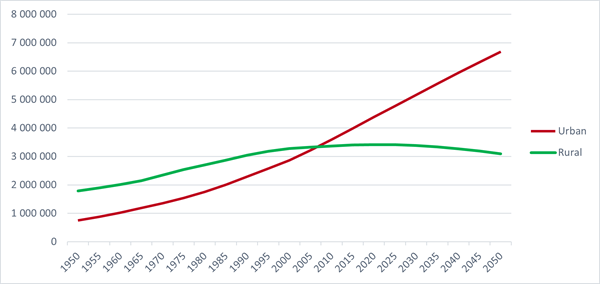- Magazine
- Smarter cities & construction
- Smart city: Constructing materially smarter cities
Smart city: Constructing materially smarter cities
In 2050 close to 70 percent of the world’s population is expected to live in cities and the need for efficient infrastructure will increase. Did you know that the materials used on satellites and space applications play a crucial role in enabling smart and safe cities of the future?
There are different definitions of what a smart city actually is. As a general interpretation, however, consensus seems to align around that the term says something about the degree to which traditional networks and services are made more efficient with use of digital and telecommunication technologies – for the benefit of its inhabitants and businesses
The smart cities put data and digital technology to work to make better decisions and improve the quality of life for example by providing commuters with real-time traffic information, an asthma patient with information on high pollution areas or live usage load in city parks.
This is important, as a study by the World Bank has found that for the first time in history, more than half of the world’s population lives in cities. The study estimates that 70 million new residents will be added to urban areas each year, indicating that more than 68 percent of the world’s population will live in cities by 2050.
Smart cities use Internet of Things (IoT) devices, like sensors, lights, and meters to collect and analyse data. The cities can then use this data to improve infrastructure, public utilities and services, and more.
IoT is the concept of connecting any device to the Internet and to other connected devices (IBM, source).

Cities are also important for value creation and according to the World Bank, 72 percent of competitive cities outperformed their countries in terms of economic growth. In other words, we need the cities and their value creation.
A potential part of the solution
The rapid urbanisation will increase demand for services in urban areas exponentially and put pressure on population centres. In this future scenario, efficient, smart cities can represent a part of the solution.
Elkem has delivered metals and materials for the construction sector for several decades and play a key role in how cities are becoming better, smarter and more efficient.
Elkem’s silicon, ferrosilicon and Microsilica® are materials used to enhance properties and reduce emissions in the production of metals and concrete for the construction sector, and Elkem’s silicones are among other things used as sealants for flexible joints between construction materials, as well as for waterproofing windows, doors and facades.
In addition, silicones also have a wide range of usages within electronics.
“The extreme resistance of our materials, combining thermal and fire resistance as well as chemical stability, make silicones materials outstanding for long-term applications, where you either do not want to or cannot change materials frequently. This is the reason why silicones have become the material of choice in aviation, aerospace and automotive industry”, says Yves Giraud, global business manager in Elkem Silicones.
“For example, if you launch a satellite, you will not be able to change and inspect the materials every three years. The materials must be stable over a 15-year period in a very challenging environment. Another example is 5G antennas, which will become increasingly important as smart infrastructure, where Elkem’s material solutions are vital to protect critical functionalities and to reduce the need for maintenance and inspections for our customers”, says Giraud.
Another example is 5G antennas, which will become increasingly important as smart infrastructure, where Elkem’s material solutions are vital to protect critical functionalities and to reduce the need for maintenance and inspections for our customers”, says Giraud.
Reliable, sustainable and innovative
With increased demand for new energy solutions and smart applications, the role of cables is also becoming more important. To meet demand, manufacturers are looking for safer, more reliable, sustainable and innovative solutions.
Silicone rubber insulated cables provides both heat and fire resistance, and present high mechanical properties. The materials therefore contribute to protecting our lives in the cities.
Another effect of smarter and more efficient cities is that the need for sensors and intelligence gathering equipment will increase. This is relevant, among other applications, on car windows, which ensure that the lights are switched on when it gets dark, or in buildings, enabling exterior doors and gates to automatically open when approached by people.
“We believe smarter cities are one of several drivers that will increase the need for safe products that last. The use of silicones in smart application is a great reusable alternative, and is also of significant sustainability value, generating energy and saving CO2 emissions nine times greater than the impacts of production and recycling”, says Giraud.